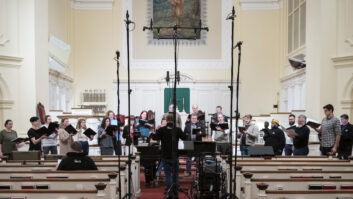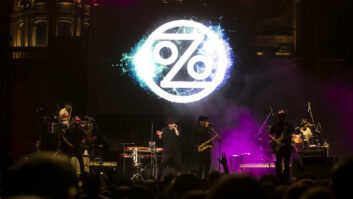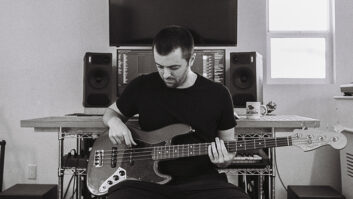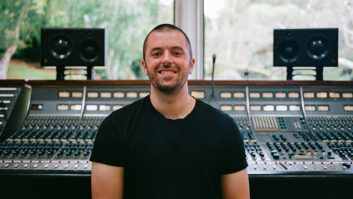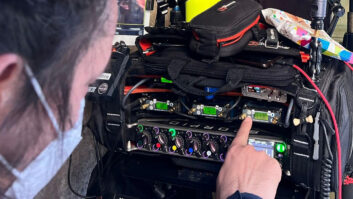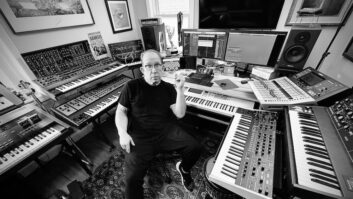The situation is no different for digital audio artisans. We spoke with a number of digital creators-ranging from an experimental choral sound artist to two remix producers whose credits are as diverse as Korn, Sarah McLachlan and Mad About You-about how they use their computer-based toolboxes, and were not surprised to find common threads in the way they work.
As with most recording projects, the degree of interaction between the producer/engineer and artist varies greatly on a remix session. “The original artist usually dumps a vocal track onto DAT for remixes, and creatively the rest is usually hands-off,” says Aaron Stipkovich, a Los Angeles-based producer with a string of remix, recording, television, film and interactive CD-ROM projects to his name. His remix credits include Chumbawamba’s “Amnesia,” Korn’s “It’s On,” Bloodhound Gang’s “I Wish I Were Queer So I Could Get Chicks,” and a Tears For Fears track. Occasionally there’s more involvement with the artists, such as on the latter’s “Mother England” remix, when “Stipko” was asked to lose a background vocal part after completing his remix. “There was a part I liked that sounded like a black female singer, but Curt [Smith, founding member] called back and asked me to bury it in the remix like he had done on the original. It was actually his voice processed through a harmonizer, but he didn’t like the digital artifacts in it. With Chumbawamba, I had no involvement with them and replaced everything but their vocals.”
Depending on the physical location of the artists he’s working with, Stipko has a variety of means and methods to create vibrant, “new” pieces. For his “Not An Addict” remix of the Belgium-based K’s Choice, it wasn’t feasible to fly the band to L.A. to add more voices to the remix, so the band sent a 2-inch tape of new vocals that Stipko dumped into Soundscape via ADAT. “We loaded the new vocals straight into Soundscape’s SSHDR-1 Pro Bus Removable system while at the same time establishing a MIDI bass line on-the-fly using Cakewalk Pro Audio 8’s rock-solid MIDI performance. They only put timecode in the first few bars to get their groove, so I had to line up the bass line while laying down a SMPTE backbone to build the rest of the remix.”
Vocals are the cornerstone of any remix session (and typically all the original artist provides), so finding the right digital tools to make the most of them is vital. One of Stipko’s favorites is VocALign from Synchro Arts, a dialog replacement plug-in he uses in Soundscape in atypical ways. “It dynamically changes time,” says Stipko, “so if you’ve got two dialog lines saying the same thing but in totally different inflections and timing, you can apply the peaks and valleys of the guide track to the target track without changing the original audio file. It’s perfect for dialog work, but I also use it to apply the groove of a live drummer to sampled drum parts or to line up vocals. You can sequence and program swings and feels, but it still feels programmed, and I could physically go in and cut up dialog files, but VocALign works instantly. I’m a huge fan of background vocals and harmonies, so I use it extensively to correct sloppy performances and timing problems.”
IT’S ALL ABOUT VOICE”The human voice covers at least a 10,000Hz range, and that’s why it’s the most complex and difficult instrument to record or sample,” says Kathy Kennedy, another producer using digital tools to capture and edit both sung and spoken word. A San Francisco-based choral and experimental sound artist who hails from the Musique Actuelle electroacoustic improvisation scene in Montreal, Kennedy opts to use Mark of the Unicorn’s Digital Performer and Digidesign’s Pro Tools to capture live performance sparks-needless to say, she is not a fan of the 100-track undertakings of vocal artists like Enya. “I see that as a massive waste of time,” she says. “People don’t sing well together with audio tracks, they sing well together with each other. People need to sing together in person; it’s the basis of my existence.”
Often using audio transpose tools in Digital Performer and Pro Tools to correct out-of-tune singers and choir sections, Kennedy also uses EQ and automation to hide mistakes without changing initial audio files. “If I hear a passage or phrase where my altos went flat, I create an EQ notch filter and use automation to mask them for a single phrase or section. I always record vocals first and never know how a large choral group’s timing will be, so I also use Performer’s Audio to Tempo tool to correct any timing lapses.”
In addition to writing, arranging and recording choral pieces, Kennedy’s own sound artist residencies at San Francisco Bay Area institutions such as the Headlands Center for the Arts, Exploratorium and The Lab have resulted in some unique performance pieces created with a digital audio tool belt. One performance about kids and violence combines rhythmic drum loops with spoken-word sound bites, but it’s the latter that’s driving the rhythm of the performance. “It’s an all-digital work,” explains Kennedy. “The voice bites are RealAudio files taken from NPR, first-hand accounts of tragedies involving kids with guns. This particularly chatty girl’s voice talking about Columbine has a rhythmic tempo about it I liked. I again used Performer’s Audio to Tempo and time-stretching tools to lock everything else up to the tempo of her voice when adding drum loops and other voices later, just the opposite of how a DJ works.”
Vocals are also important to A&R staffs, though most remix producers don’t share their concerns about the ways they are enhanced. “Sarah McLachlan gave us some vocals for the ‘I Love You’ remix that were originally tracked at 80 bpm, very slow,” recalls Brian Transeau, a remix and recording producer in Los Angeles. “Our progressive house mix of the song needed to be at least 135 bpm, so to simply time-stretch her voice that far would tamper with her incredible natural vibrato and obviously wouldn’t work. It’s trendy for record people these days to tell remixers, ‘Don’t even think about time-stretching the vocals!’ I tell them I won’t, then I launch Steinberg’s Time Bandit as soon as I’m off the phone. I slowed the tempo down to 67 bpm for Sarah’s piece, then double-timed it in Time Bandit, and not even Sarah can hear the difference.”
Transeau, who attended the Berklee College of Music, has credits ranging from writing the score for the movie Go to remixing Madonna’s “Swim” from Ray of Light to producing his own progressive electronica and ambient discs. But you’d be hard-pressed to find him tinkering with MIDI files beyond his initial creative process. “I’m so over MIDI,” he says. “Trying to stuff all kinds of controllers and note data down a 4MHz modem cable is ridiculous because there are serious MIDI timing problems, especially on Macs. Create a basic four-count drum part in MIDI, record it as audio, and if you look close enough you’ll see the kick drums falling before or after the downbeat. Whether I’m working on a remix, a soundtrack or my own stuff, it always ends up as audio data once I’m through creating it because the creative possibilities with digital audio go way beyond MIDI.
“I’ll use MIDI to come up with compositional ideas offline from my recording system, then bang it into Pro Tools where I can manually correct absolutely everything I record,” he explains. “I line up the down beat, then go to every 16th note or 32nd or whatever and time-stretch the tail ends of everything a bit too long so I can cut them up and do a fade-up and a fade-down for each note. It takes forever and typically adds another three days to most single-track projects and remixes I do, but the difference in the feel is astonishing.”
The break beats for “Love on Haight Street,” a new Transeau track from his upcoming solo disc, were created with an Ensoniq ASR-10-but that’s as far as MIDI could go for him. “It’s a great feel tool for beats, but it was getting to the point where the timing was way too sloppy,” he says. “I made a quantize template out of audio in Emagic Logic, then corrected all the other audio to that. I’ll apply some plug-ins to a track, add some reverb, flip it around, add some backwards reverb, flip it back again, sometimes doing up to 30 edits within a single bar of music. It’s time-consuming, but until they come out with Firewire MIDI, this is how I’ll always work.”
SOFTWARE NUGGETS AND TOOL JEWELSThe wonders of the well-stocked digital audio desk are deep and wide, but a producer’s bag of tricks and surprisingly inexpensive helper tools never cease to amaze and inspire. Ask any remixer, engineer or recording artist with a six-figure budget about their favorite toys, and they’ll take great pride in crediting their success to an obscure software feature, free program or homemade retro gadget. Seems that sonic performance artists and techno remixers have more in common with Radio Shack, shareware and Walkmans than they might ever admit.
Packing 36 vocalists into a small studio was no easy task for Kennedy, and that was before putting on and powering up a pair of studio headphones on each singer to hear the click. Using a free schematic found on the Web and cheap parts from Le Shack, she built her own FCC-legal, under 10-watt radio transmitter to beam the click into each singer’s personal stereo headphones over a low-band FM frequency. Her “Cell Phone Ballet,” performed with three other singers roaming around San Francisco’s cavernous Exploratorium, used the same concept over cell phone lines to help create a seamlessly synched performance.
Stipko uses his two Soundscape recording systems, racks of outboard gear and four large-screen monitors to great ends, but one of his little secrets is a 500K PC shareware program. Emulating tape stop (the stopping of a tape deck by hand, which is popular in hip hop, rap, techno and remixes), the $15 Gold Wave can do what Soundscape, Pro Tools or any other sophisticated recording platform cannot without sounding too digital. Rather than going out to tape to physically do this or dealing with the inherent artifacts left when trying it digitally, Stipko prefers Gold Wave’s artifact-free, 20-bit performance with its wide range of PC, Mac, Sun and other audio format support. He’s created a link on his Web site at www.stipko.com/goldwave for Mix readers interested in downloading this little gem.
Similarly, avid Mac fanatic Transeau uses Fruityloops and Little Drummer Boy, two tiny PC programs for programming slammin’ drum patterns. Created in Sweden by a mathematician, Little Drummer Boy provides great 808- and 909-style pattern generators, from which Transeau sends the audio output via Lightpipe back into Pro Tools.
Host CPU budgets also have a lot to do with how the same digital audio applications are used on different platforms. One’s ceiling may be another’s floor when it comes to system resources, but the challenges of a light toolbox can be inspiring. “My Apple 8600 is as lean as it could possibly be,” Kennedy admits. “Time-based effects like flange, phasing and delay are just electronic ways of describing what happens when a stereo sound file is put in and out of phase to varying degrees, so I’ll drag one channel ahead or behind the other by 50 milliseconds to create a lush chorus-great for the choral work I do. Best of all, it gives my CPU a break by not running plug-ins for all the effects I love to use.”
Conversely, Stipko’s upstairs rig is geared for practically unlimited plug-ins, EQs and individual channel dynamics processors. “Because CPUs have gotten so fast and Soundscape’s dedicated chips take all the load off the host computer, I’m allowed the freedom of using plug-ins almost exclusively,” he says.
FIX IT IN THE REMIXThe gear, techniques and interactions with artists are not unlike those of any tracking studio, but what’s the view like from a remix desk? “It’s a world of difference,” says Stipko. “Our tracking desk is your usual billion-input board, there’s tons of mics, preamps and outboard gear, but I spend 90 percent of my remix time at a desk-and I mean that in the furniture sense. There are $100 million tracking facilities out there, so it’s silly to try and compete with the Record Plants of the world.”
His setup includes two Soundscape systems, Cakewalk Pro Audio 8, four flat-screen monitors, a JLCooper CS-10 MIDI controller box, a synth, a keyboard and a mouse. “I use a standard 48-track mixer setup in Soundscape when I’m running a bunch of ADATs or DA-88s,” Stipko continues. “On one screen I have video for film or TV work, another has the Soundscape mixer up, another the Cakewalk MIDI arrangement, and another for miscellaneous utilities and plug-ins. The gear is different for each, but I can literally switch from a feature film sound effect session to remix mode in five seconds.”
Stipko is spending most of his time this year looking for his own remixers-music fans. He’s developing interactive CD-ROM albums for artists that let the user remix their favorite tracks to the band’s videos. “It’s a musical browser interface based on Headspace’s Beatnik engine that lets them build loops and remix several drum, bass, guitar, keyboard and vocal parts from the album, all automatically in sync.”
The majority of remixes tend to lean toward hip hop, electronica, techno, rock and pop, but why don’t we hear jazz, blues or classical remixes? “It’s funny you should ask about classical remixes,” says Transeau. “William Orbit [Madonna’s producer] just asked me to remix a song from his upcoming album of reinterpreted classical pieces, either Barber’s Adagio for Strings or something from Gorecki, my favorite composer. I’m a Berklee-trained classical pianist, and maybe classical is just too sacrilegious to be tampered with, but jazz is meant to be experimental and improvisational. The rhythmic nature of jazz is ripe for the beat and loop nature of today’s digital remix tools. Remixes also give record companies the cool street label an artist might need to cross over or to expand their audience, so some folks are experimenting more with their remixes. The way things are going, our children’s children’s favorite songs will be pink noise bursts!”

